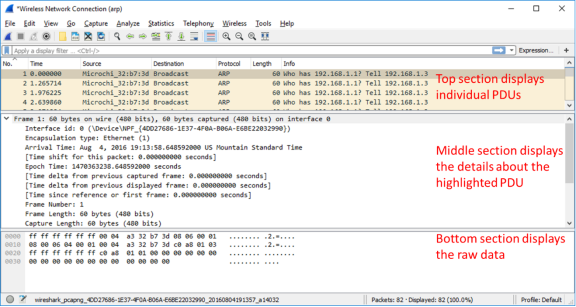

Originally known as Ethereal, Wireshark displays data from hundreds of different protocols on all major network types. Capture filters are applied as soon as you begin recording network traffic. Application Layer Transport Layer Network Layer Data Link Layer Physical Layer Now we understand that the above layers are not exactly OSI or TCP/IP but a combination of both models. The SampleCaptures page includes which shows VLAN tags. Wireshark is an open source network packet analyzer.
#PDU LAYERS IN WIRESHARK INSTALL#
Depuis un terminal en administrateur : apt-get install wireshark Pour utiliser Wireshark avec un autre utilisateur que root. In this case, the higher layer PDU is split into several PDUs from the lower layer. List the PDU at layers 2, 3, and 4 that were used to transmit your HTTP GET packet. Why is wireshark interpreting RTP and RTCP as Skype traffic? With lots of help, I now understand that a Lua dissector that is meant to extract multiple higher-level PDUs from a given TCP segment must implement its own loop. You'll see the latest stable release and the current developmental release. As TCP & UDP PACKETS ANALYSIS USING WIRESHARK … In the Sharing & Permissions settings, give the admin Read & Write privileges. Hi, I use Wireshark for SIP/RTP debugging and the player under Telephony menu reproduce alas RTP streams very bad. Anyway, there is only one call because the Wireshark had a Capture Filter to track information between one source and one destination IP address. If save of audio is not possible (unsupported codec or rate), silence of same length is saved and warning is shown. Asynchronous DNS resolution is always enabled. Fortunately, filters are part of the core functionality of Wireshark and the filter options are numerous.
#PDU LAYERS IN WIRESHARK PLUS#
Once the PDU reaches the destination, the attached header and footer PDU elements are ripped off one by one as it passes through each layer … Lisez la suite pour obtenir des conseils plus avancés si vous souhaitez utiliser Wireshark comme un pro. au supports any codec with 8000 Hz rate supported by Wireshark (shown in RTP player).

They also make great products that fully integrate with Wireshark. When a packet is selected in the top pane, you may notice one or more symbols appear in the No.

In Wireshark -> Under Statistics ->I have VoIP calls. You might get some hints by looking at the way that req_resp_hdrs_do_reassembly() handles reassembling the HTTP header.Pdu layers in wireshark Colorize Packet List to toggle packet colorization on and off.
#PDU LAYERS IN WIRESHARK HOW TO#
Sadly, there's not much in the way of helper routines or documentation for how to do that. There's currently no built-in mechanism to handle reassembly of arbitrary protocols where the length is determined by a terminator, so you'd have to implement reassembly yourself. Tcp_dissect_pdus() is for protocols where 1) there's a minimum length for a PDU and 2) if you have that many bytes of data from the beginning of the PDU, you can determine the length, either by extracting it from a length field, or by looking at the PDU type and determining the length based on that, or some other such mechanism.

The routine that does reassembly for "request/response protocols", meaning "protocols that work somewhat like HTTP", req_resp_hdrs_do_reassembly() handles the blank-line terminator for the header and the Content-Length header for the body. For HTTP, for example, there's no length field for the HTTP header - it continues until there's a blank line - so reassembling HTTP requests and replies doesn't use tcp_dissect_pdus(). How do you determine the PDU length when there is no length field?


 0 kommentar(er)
0 kommentar(er)
